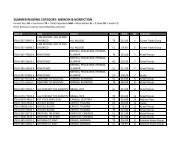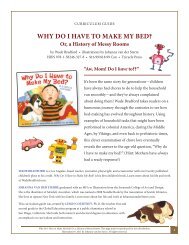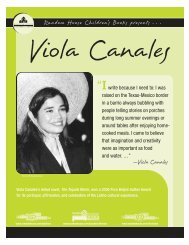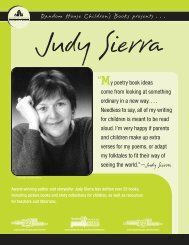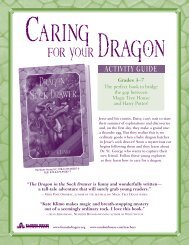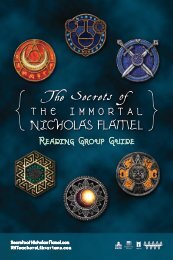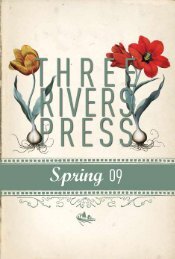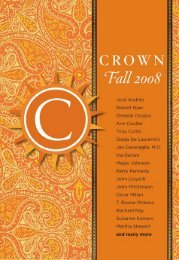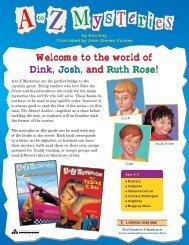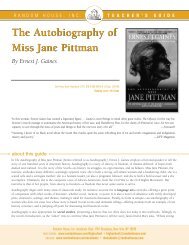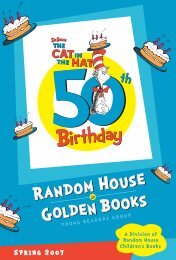Bullying Discussion Guide - Random House
Bullying Discussion Guide - Random House
Bullying Discussion Guide - Random House
You also want an ePaper? Increase the reach of your titles
YUMPU automatically turns print PDFs into web optimized ePapers that Google loves.
<strong>Bullying</strong><br />
Book <strong>Discussion</strong> <strong>Guide</strong><br />
Includes Connections to Common Core State Standards<br />
RHTeachersLibrarians.com
Dear Colleague,<br />
<strong>Bullying</strong> and relational aggression have received a lot of media attention recently, but these are<br />
not new problems. What is new is society’s attitude towards bullying and relational aggression.<br />
What used to be accepted as a natural part of growing up has our full attention because now we<br />
know that bullying has serious consequences for everyone involved. Stop and think for a moment<br />
about your own experiences growing up. We all have memories of being teased, taunted, excluded,<br />
bullied, and harassed in childhood and even in adulthood. Many of us have memories of being<br />
the bully ourselves. We know that the emotional scars of bullying are painful and permanent. We<br />
want healthier social and emotional experiences for the children in our lives. <strong>Bullying</strong> prevention<br />
is everyone’s responsibility. As educators, we must be willing to take a stand for the social and<br />
emotional well being of all of the children placed in our care.<br />
As a primary school counselor, I am devoted to the prevention of bullying behaviors. Every student<br />
can benefit from gaining the knowledge and skills needed to safely and effectively address bullying<br />
behaviors if encountered in any setting. My goal is to empower children to stand up for themselves<br />
and each other. My bullying prevention lessons are focused on developing a school culture of<br />
kindness and compassion; effective communication; problem solving and conflict management skills;<br />
strategies for standing up for themselves and others; and reinforcing the importance of reporting<br />
bullying behaviors to trusted adults.<br />
I believe strongly in the importance of quality literature for children to teach social and emotional<br />
skills. For my class lessons, I seek out books that are well written, relevant, and meaningful with<br />
believable characters that are relatable to children. I know what the current issues are in our<br />
classrooms, on our playgrounds, and on our buses, so I am able to plan my lessons according to need.<br />
Trudy Ludwig’s books—My Secret Bully, Just Kidding, Sorry, Trouble Talk, Too Perfect, Confessions of a<br />
Former Bully, Better Than You and The Invisible Boy—are the core of my counseling curriculum. Ludwig<br />
is a powerful advocate for children and her books address issues of relational aggression while<br />
developing empathy and resiliency in children. Her books also provide research-based information<br />
to educate and support adults to empower children with social and emotional skills to navigate their<br />
complicated social worlds.<br />
As bullying becomes a greater concern in the lives of young adults, we must look to well-written<br />
novels with believable characters in real-life situations. These books can bring social problems out<br />
into the light in a nonthreatening manner, and create teachable moments for engaging students in<br />
rich discussions in which problem solving and emotional support can occur. Wonder by R. J. Palacio,<br />
Twerp by Mark Goldblatt and The Dark Days of Hamburger Halpin by Josh Berk address directly<br />
issues of bullying, cyberbullying, stereotypes, popularity, peer pressure, dating violence, exclusion,<br />
intentional, and unintentional bullying. In each of these novels, empathy, kindness, and friendship<br />
overrule bullying.<br />
Laura Barbour<br />
School Counselor<br />
Laura Barbour, M.A., has taught and counseled children from preschool through high school in a variety of educational and mental health settings<br />
for over 20 years. She presently works as an elementary professional school counselor at Stafford Primary School in West Linn, Oregon.
Pre-Reading Activity: Stand Up In Silence<br />
OBJECTIVES<br />
• To further develop a culture of compassion and<br />
caring in our classrooms and school community.<br />
• To sensitize students to the effects of bullying,<br />
stereotyping, prejudice, ridicule, teasing, and<br />
other hurtful behaviors.<br />
• To address character traits of justice, fairness,<br />
tolerance, empathy, integrity, respect,<br />
responsibility, compassion, and courage.<br />
• To identify the different roles in bullying<br />
behaviors and acknowledge the roles we play.<br />
INTRODUCTION<br />
I am going to read several statements out loud. If I<br />
read a statement that is true for you, please quietly<br />
stand up. If I read a statement that is not true for<br />
you, please remain seated or sit down.<br />
You may have strong feelings during this activity. It<br />
is important that we honor each other’s feelings by<br />
doing this activity in silence.<br />
ACTIVITY<br />
1. Stand up if you have been teased about the<br />
clothes you wear, your height, your weight, or<br />
the size or shape of your body.<br />
2. Stand up if you have ever been teased or made<br />
fun for how you look or talk.<br />
3. Stand up if you have ever been put down, teased,<br />
or excluded because of the color of your skin.<br />
4. Stand up if you have ever been put down, teased<br />
or excluded because of your faith or religious<br />
beliefs.<br />
5. Stand up if you have used words to hurt others<br />
by calling them names or putting them down.<br />
6. Stand up if you’ve been on the giving or<br />
receiving end of the silent treatment or<br />
intentional exclusion from a group, game,<br />
or activity.<br />
7. Stand up if you’ve smiled, laughed, clapped,<br />
or remained silent when someone was being<br />
teased or bullied in front of you.<br />
8. Stand up if you’ve ever emailed, texted, or<br />
posted something online about someone that<br />
you wouldn’t say face-to-face.<br />
9. Stand up if you’ve been told that you look or act<br />
like a boy or a girl and that is not who you are.<br />
10. Stand up if you have ever been on the<br />
receiving or giving end of comments like<br />
“loser” or “retard.”<br />
11. Stand up if you’ve been told by someone who<br />
you can and cannot be friends with.<br />
12. Stand up if you’ve ever felt pressure from<br />
friends to do something you didn’t want to do<br />
and felt sorry or ashamed afterwards.<br />
13. Stand up if you’ve spread rumors or gossiped<br />
about someone else.<br />
14. Stand up if you or someone you know was<br />
physically or emotionally hurt and you were too<br />
uncomfortable or afraid to say something.<br />
DEBRIEF<br />
It takes courage to stand up. Everyone here knows<br />
what it feels like to get hurt, to see someone be<br />
hurt, and to cause the hurt. When you stood up, you<br />
remembered what it feels like to be the target, the<br />
bystander, or the bully. That is what empathy feels<br />
like. If we can remember what we’ve learned here<br />
today—that we’ve all been hurt by bullying—we<br />
will stand up, speak up, and stop others from being<br />
hurt. We share a collective responsibility to prevent<br />
bullying behaviors.<br />
Remember: It is a choice! If you don’t like how you<br />
are being treated or how you are treating others, do<br />
something about it. You choose which role<br />
you play.<br />
If you are a target of bullying, report it to an adult<br />
you trust at school and an adult you trust at home.<br />
If you are a bystander, be a hero! Stand up!<br />
Comfort the target. Include the target. Report it<br />
to an adult.<br />
If you are a<br />
bully, get<br />
help! Talk<br />
to an adult<br />
you trust and<br />
learn skills to<br />
manage your<br />
emotions and<br />
behavior.<br />
Note to Educators:<br />
This is a powerful activity<br />
that may provoke strong feelings<br />
in your students. It is essential<br />
that this lesson be taught in an<br />
emotionally safe and respectful<br />
environment. The language in<br />
the activity should be adapted<br />
based on your audience.
Vocabulary Ask students to defi ne the following words:<br />
• bully<br />
• target<br />
• bystander<br />
• upstander<br />
• teasing<br />
• taunting<br />
• inclusion<br />
• exclusion<br />
• harassment<br />
• cyberbullying<br />
• tattling<br />
• reporting<br />
• put-ups<br />
• popularity<br />
• clique<br />
• peer pressure<br />
• stereotype<br />
• discrimination<br />
• prejudice<br />
• tolerance<br />
• cooperation<br />
• competition<br />
• empathy<br />
• kindness<br />
• compassion<br />
• politically correct<br />
language<br />
• people-fi rst language<br />
Featured titles by trudy ludwig<br />
MY SECRET<br />
BULLY<br />
Illustrated by<br />
Abigail Marble<br />
Tricycle Press • Grades 1–4<br />
HC: 978-1-58246-159-5<br />
Here is the all-too-familiar<br />
story of Monica. She and<br />
Katie have been friends since<br />
kindergarten. Monica loves<br />
being around her when she’s nice. But there are times<br />
when Katie can be just plain mean. And Monica doesn’t<br />
understand why.<br />
THE<br />
INVISIBLE<br />
BOY<br />
Illustrated by<br />
Patrice Barton<br />
Alfred A. Knopf • Grades 1–4<br />
HC: 978-1-58246-450-3<br />
GLB: 978-1-58246-451-0<br />
Meet Brian, the invisible<br />
boy. Nobody ever seems to<br />
notice him or think to include him in their group, game, or<br />
birthday party . . . until, that is, a new kid comes to class.<br />
JUST<br />
KIDDING<br />
Illustrated by<br />
Adam Gustavson<br />
Tricycle Press • Grades 1–4<br />
HC: 978-1-58246-163-2<br />
D.J.’s friend Vince has a<br />
habit of teasing D.J. and then<br />
saying, “Just kidding!” as if<br />
it will make everything okay.<br />
It doesn’t, but D.J. is afraid that if he protests, his friends<br />
will think he can’t take a joke.<br />
TROUBLE<br />
TALK<br />
Illustrated by<br />
Mikela Prevost;<br />
Foreword by<br />
Charisse L. Nixon<br />
Tricycle Press • Grades 1–4<br />
HC: 978-1-58246-240-0<br />
Maya’s friend Bailey loves<br />
to talk about everything and<br />
everyone. At first, Maya<br />
thinks Bailey is funny. But when Bailey’s talk leads to<br />
harmful rumors and hurt feelings, Maya begins to think<br />
twice about their friendship.
Exploring Trudy Ludwig’s<br />
Picture Books<br />
Trudy Ludwig is an award-winning author who<br />
specializes in writing children’s books that explore the<br />
colorful and sometimes confusing world of children’s<br />
social interactions. Visit her website at TrudyLudwig.com<br />
Photo © Ken Long<br />
My Secret Bully<br />
Paper doll activity—<br />
prepared by Trudy Ludwig<br />
• Cut a large paper doll out of butcher paper and<br />
decorate it to look like a girl.<br />
• Read My Secret Bully by Trudy Ludwig.<br />
• Have the kids take turns calling out specific<br />
incidents in My Secret Bully in which Monica was<br />
intentionally hurt by Katie. Scrunch up the paper<br />
doll with each example.<br />
• Once the paper doll is completely scrunched,<br />
explain to the children that bullying can crush the<br />
human spirit, but that you can get built back up<br />
again with the helpful support of allies—adults<br />
and peers.<br />
• Have the students now take turns calling out<br />
specific incidents in the story that illustrate who<br />
in the story helped Monica and how. As they<br />
give their examples, unfurl the crumpled doll,<br />
explaining how having allies or people who<br />
support you can build up the human spirit.<br />
• Ask the kids, “Now that she’s built back up again,<br />
what do you see on the doll?” Kids will point out<br />
that the doll now has wrinkles. Share with the<br />
kids that the wrinkles are the scars of the heart.<br />
Explain how all of us have scars somewhere on<br />
our bodies that are lifelong reminders of what<br />
happened to us as kids. Share with them that you<br />
have a scar on your body, a memory marker of<br />
what had happened to you when you were a child.<br />
• Ask the kids, “If you can touch your scar, does<br />
it hurt?” They’ll say, “No.” Tell them, “That’s<br />
because your skin has toughened up. YOU have<br />
toughened up, but that scar is a lifelong memory<br />
of what had happened to you when you were a kid.”<br />
• Now ask the adults in the classroom to raise their<br />
hand if they remember, as a child: a) watching<br />
others getting intentionally hurt; b) being the<br />
one who was hurt; or c) being the one who hurt<br />
another. Usually, every adult hand goes up. This<br />
lets kids know that even adults have gone through<br />
hurtful experiences as children, and they’ve<br />
gotten through them. They’re okay now, but they<br />
still carry that memory of hurt with them.<br />
• End this activity by encouraging the kids to<br />
remember the power of their words and their<br />
actions: They have the power to create memories<br />
of kindness or memories of cruelty for others.<br />
They should use their power to create memories<br />
of kindness.<br />
CONFESSIONS OF A FORMER BULLY<br />
Illustrated by Beth Adams<br />
Tricycle Press • Grades 3–7<br />
HC: 978-1-58246-309-4<br />
GLB: 978-1-58246-358-2<br />
PB: 978-0-307-93113-9<br />
• Read Confessions of a Former<br />
Bully as an extension or<br />
closure to My Secret Bully.<br />
• Teach about the roles of<br />
bullying and develop<br />
compassion and empathy for<br />
the bully, target, bystander, and hero bystander.<br />
• Explore perspective and author’s voice by<br />
comparing Confessions of a Former Bully and<br />
My Secret Bully.<br />
Correlates to Common Core State Standard Reading Literature: RL.K.1; RL.1.1; RL.2.3; RL.2.1; RL.3.1; RL.4.1; RL.5.2; and RL.5.3
Exploring Trudy Ludwig’s Picture Books<br />
THE INVISIBLE BOY<br />
Ask students, “What is it? What does it look<br />
like? What does it feel like?” Make a T-chart to<br />
brainstorm examples of inclusion and exclusion.<br />
Ask students to share their own experiences. How<br />
does it feel to be excluded? How does it feel to be<br />
included? How can we work and play together<br />
cooperatively to ensure that everyone is included?<br />
Role play relevant scenarios with your class. For<br />
example: You enjoy playing kickball during recess.<br />
The same two students are always captain and they<br />
choose their friends to play on their teams. You<br />
notice the same student does not get chosen for<br />
kickball day after day.<br />
• What would you do if this happened to you?<br />
• What would you do if you saw this happen to<br />
someone else?<br />
• What would you say or do to include the student<br />
who is being left out?<br />
• What is our commitment to address the issue<br />
of exclusion? What can we do to prevent it from<br />
happening?<br />
JUST KIDDING<br />
Explain to students, “I am going to ask a series<br />
of questions and I want you to think about your<br />
answer without saying anything out loud, nodding,<br />
or raising your hands.”<br />
• Have you ever been made fun of or teased<br />
by a friend?<br />
• Has a friend ever called you a name<br />
you didn’t like?<br />
• Have you ever been excluded by your friends?<br />
• Has a friend ever used humor to hurt you?<br />
• Has a friend ever hit or hurt you and<br />
claimed it was just a joke?<br />
Teasing can be a playful way to show affection and<br />
have fun, but it can go too far and feelings can get<br />
hurt. However, if the teasing hurts, humiliates,<br />
ridicules, or demeans another person, then the<br />
teasing has crossed the line into taunting. Taunting<br />
is a form of emotional bullying or relational<br />
aggression that can be hurtful. This story is about a<br />
friend who takes teasing too far.<br />
<strong>Guide</strong> your students in an activity to identify the<br />
difference between playful teasing and hurtful<br />
taunting. Using a T-chart, brainstorm examples<br />
with your class based on their experiences with<br />
teasing. Categorize each example under the<br />
heading of “Teasing” or “Taunting.” This activity<br />
will clarify the fine line between playful teasing<br />
and hurtful taunting.<br />
TROUBLE TALK<br />
Sticks and stones may break my bones<br />
but words can break my heart.<br />
1. Invite students to sit in a large circle. Tell them<br />
they are going to play the Telephone Game.<br />
2. Whisper a statement or brief story in the ear of<br />
the person sitting to your right. Tell the student<br />
to whisper the statement to the next person.<br />
Continue until everyone has heard the statement.<br />
Have the last student in the circle say aloud what<br />
he or she heard. Tell what the original statement<br />
or story actually was. Have students compare<br />
the original to the final statement and note any<br />
changes.<br />
3. Explore ways that a story can change as it is<br />
retold and discuss how this can lead to rumors.<br />
4. Explain to students that this is an example of<br />
“trouble talk.”<br />
Correlates to Common Core State Standard Reading Literature:<br />
RL.K.1; RL.1.1; RL.2.3; RL.2.1; RL.3.1; RL.4.1; RL.5.2; and RL.5.3
Exploring Middle-Grade & Young Adult Books<br />
Featured titles<br />
TWERP<br />
Mark Goldblatt <br />
<strong>Random</strong> <strong>House</strong> • Grades 4–7<br />
HC: 978-0-375-97142-6<br />
GLB: 978-0-375-97143-3<br />
Julian Twerski isn’t a<br />
bully. He’s just made a big<br />
mistake. So when he returns<br />
to school after a weeklong<br />
suspension, his English<br />
teacher offers him a deal:<br />
if he keeps a journal and<br />
writes about the terrible<br />
incident that got him and<br />
his friends suspended, he can get out of writing a report on<br />
Shakespeare. Julian jumps at the chance.<br />
And so begins his account of life in sixth grade —blowing up<br />
homemade fireworks, writing a love letter for his best friend<br />
(with disastrous results), and worrying whether he’s still the<br />
fastest kid in school. Lurking in the background, though, is<br />
the one story he can’t bring himself to tell, the one story his<br />
teacher most wants to hear.<br />
THE DARK<br />
DAYS OF<br />
HAMBURGER<br />
HALPIN<br />
Josh Berk <br />
Alfred A. Knopf • Grades 7 up<br />
PB: 978-0-375-84625-0<br />
HC: 978-0-375-85699-0<br />
Being a hefty, deaf newcomer<br />
almost makes Will Halpin the<br />
least popular guy at Coaler<br />
High. But when he befriends<br />
the only guy less popular than him, the dork-namic duo<br />
has the smarts and guts to figure out who knocked off the<br />
star quarterback. Will can’t hear what’s going on, but he’s<br />
a great observer. So, who did it? And why does that guy<br />
talk to his fingers? And will the beautiful girl ever notice<br />
him? (Okay, so Will’s interested in more than just murder. . . .)<br />
WONDER<br />
R. J. Palacio<br />
Alfred A. Knopf • Grades 3–7<br />
HC: 978-0-375-86902-0<br />
GLB: 978-0-375-96902-7<br />
August Pullman was born<br />
with a facial deformity that,<br />
up until now, has prevented<br />
him from going to a<br />
mainstream school. Starting<br />
fifth grade at Beecher Prep,<br />
he wants nothing more than<br />
to be treated as an ordinary<br />
kid—but his new classmates<br />
can’t get past Auggie’s extraordinary face.<br />
Wonder, now a #1 New York Times bestseller and<br />
included on the Texas Bluebonnet Award master list, begins<br />
from Auggie’s point of view, but soon switches to include<br />
his classmates, his sister, her boyfriend, and others. These<br />
perspectives converge in a portrait of one community’s<br />
struggle with empathy, compassion, and acceptance.<br />
“SHALL WE MAKE<br />
A NEW RULE OF<br />
LIFE . . . ALWAYS<br />
TRY TO BE A LITTLE<br />
KINDER THAN<br />
IS NECESSARY?”<br />
—J. M. BARRIE<br />
Illustration © 2006 by Adam Gustavson<br />
from JUST KIDDING by Trudy Ludwig.
Exploring Middle-Grade & Young Adult Books<br />
SOCIAL STATUS<br />
We know that bullying can result from an<br />
imbalance of power and social status. Recent<br />
research indicates that social isolation is a<br />
significant risk factor for children and teens to be<br />
targets of bullying. Shy, quiet, passive children are<br />
at greater risk for being the target of aggression<br />
and bullying. Social power and social connection<br />
are risk factors for children and teens to bully their<br />
peers. Put simply, popular students are more likely<br />
to bully unpopular students.<br />
DISCUSSION QUESTIONS<br />
• What does it mean to be popular?<br />
• How are cliques formed?<br />
• What are the social boundaries at your school?<br />
• How is one’s social status determined?<br />
• What characteristics are valued in boys? In girls?<br />
• What characteristics result in someone<br />
being socially outcast?<br />
• Can someone change his/her social status? How?<br />
• How does social status contribute to bullying?<br />
ACTIVITY<br />
Rank the following qualities in the order<br />
of importance according to social status at<br />
your school:<br />
• Appearance<br />
• Character<br />
• Material possessions<br />
• Athletic ability<br />
• Academic performance<br />
• Sense of Style<br />
• Parental Social Economic Status<br />
• Personality<br />
• Sense of Humor<br />
“Nobody can hurt me<br />
without my permission.”<br />
—MAHATMA GANDHI<br />
CONNECTION TO LITERATURE<br />
Students who are targets of bullying are perceived<br />
as different from other students due to their size,<br />
race, sexuality, disabilities, or different interests.<br />
They may appear to be weak or insecure and seek<br />
approval from their peers. Targets of bullying are<br />
often students who don’t report the behavior to<br />
adults for fear of retaliation.<br />
What factors contributed to students being bullied<br />
in Wonder, Twerp, and The Dark Days of Hamburger<br />
Halpin?<br />
What was Will Halpin’s social status at the<br />
beginning of The Dark Days of Hamburger Halpin?<br />
What was his social status at the end of the book?<br />
How did he change his social status? What qualities<br />
determined in popularity at Carbon High School?<br />
What was Auggie’s social status at the beginning<br />
of Wonder? What factors determined Auggie’s social<br />
status at Beecher Prep? As classmates got to know<br />
Auggie, what character traits were valued? How<br />
did Auggie change his social status in the story?<br />
How did Auggie change the social dynamics at<br />
Beecher Prep?<br />
What qualities determined social status among the<br />
characters in Twerp? Which character had the most<br />
social power? What characteristics were valued<br />
among Julian’s friends? Did Julian’s social status<br />
change in the story? How did Julian change his<br />
social status?<br />
POPULARITY &<br />
PEER PRESSURE:<br />
Be True To You<br />
How do you remain true to yourself without giving<br />
into peer pressure or following the crowd? It is<br />
important to find friends who share your interests,<br />
values, and beliefs. When you are with these<br />
friends, you feel comfortable being yourself and<br />
speaking your mind. These friends are your allies.<br />
DISCUSSION QUESTIONS<br />
• Is it more important to be popular and follow the<br />
crowd or be true to yourself?
Exploring Middle-Grade & Young Adult Books<br />
• Is peer pressure an issue at your school<br />
or with your group of friends?<br />
• How do you respond to peer pressure?<br />
• How does peer pressure contribute to bullying?<br />
• Think about a time when you stood up for<br />
something you believed in. How did you do it?<br />
How did you feel?<br />
• When you stood up for something you believed<br />
in, how did others treat you? Were you respected<br />
for being honest and true to yourself?<br />
• Have you even been in a situation when you wish<br />
you had stood up for something you believed in?<br />
How did you feel?<br />
• Do you and your friends stand up to bullying?<br />
How do you stand up for one another?<br />
CONNECTION TO LITERATURE<br />
Who are Auggie’s allies in Wonder? How do<br />
Auggie’s friends, family, and teachers stand up for<br />
him? Did peer pressure have an impact on bullying<br />
in Wonder? Give examples of students standing up<br />
to peer pressure? Give examples of students giving<br />
in to peer pressure? Do you believe that kindness<br />
can win out over bullying?<br />
Why did Julian give in to peer pressure in Twerp?<br />
Was Julian being true to himself when he played<br />
along with Lonnie’s dares? Why did he participate<br />
in Scrambled Dope Day? Does Julian stand up for<br />
what he knows is right?<br />
How does Julian accomplish being true to himself?<br />
Who are Julian’s allies?<br />
Who are Will’s allies in The Dark Days of Hamburger<br />
Halpin? How do characters in the story respond<br />
to peer pressure? What characters remain true to<br />
themselves throughout the story? How did Will<br />
stand up for himself and others?<br />
Correlates to Common Core State Standard English Language Arts<br />
Grade 6–8; Production and Distribution of Writing: Literacy.WHST.6-8.4:<br />
Literacy. WHST.6-8.5 and Literacy. WHST.6-8.6; Research to Build and<br />
Present Knowledge: Literacy. WHST.6-8.7; Literacy. WHST.6-8.8 and<br />
Literacy. WHST.6-8.9; Range of Writing: Literacy. WHST.6-8.10<br />
TEACHING KINDNESS<br />
CONNECTION TO LITERATURE<br />
Wonder is the ideal novel for teaching the power<br />
of kindness, compassion, and empathy. There are<br />
many examples of bullying behaviors in Wonder<br />
overshadowed only by endearing acts of kindness.<br />
• Compare and contrast incidences of bullying and<br />
incidences of kindness in Wonder.<br />
• Using available technology, make your own video<br />
book trailer to promote Wonder. Check out the<br />
<strong>Random</strong> <strong>House</strong> book trailer at SchoolTube.com.<br />
• Publish, film, or blog a collection of your students’<br />
precepts.<br />
• Research Treacher Collins Syndrome/<br />
Mandibulofacial Dysostosis and prepare, class<br />
presentation, PowerPoint presentation, or<br />
brochure.<br />
• Host a Disability Awareness Week at your school<br />
• Train peer advocates to provide social support<br />
and friendship for students with special needs in<br />
your school.<br />
• Start a kindness campaign in your school<br />
community. Students can work together to create<br />
a public service announcement for your school.<br />
Choose kind is an<br />
anti-bullying initiative<br />
inspired by WONDER.<br />
Visit choosekind.tumblr.com<br />
to share your story and pledge<br />
to CHOOSE KIND in your school<br />
and community! You can also<br />
join the conversation on Twitter:<br />
#thewonderofwonder
Exploring Middle-Grade & Young Adult Books<br />
I AM NOT A STEREOTYPE<br />
A stereotype is a fixed, commonly held notion<br />
or image of a person or group, based on an<br />
oversimplification of some observed or imagined<br />
trait of behavior or appearance. Stereotypes can<br />
be either positive or negative. But most stereotypes<br />
tend to make us feel superior in some way to the<br />
person or group being stereotyped. Stereotypes<br />
ignore the uniqueness of individuals by painting<br />
all members of a group with the same brush.*<br />
Ask students to write their own definition of the<br />
word stereotype.<br />
DISCUSSION QUESTIONS<br />
• Why do you think people stereotype others?<br />
• What are labels? Do you think labels are helpful<br />
or hurtful?<br />
• Give examples of ways people are labeled by<br />
stereotypes.<br />
• What happens when we generalize people based<br />
on labels and stereotypes?<br />
• What examples of stereotyping caught your<br />
attention in Wonder, Twerp and The Dark Days of<br />
Hamburger Halpin?<br />
• What examples of labels and stereotypes do you<br />
witness in school? What examples of stereotypes<br />
do you witness in literature and media?<br />
• Have you ever been stereotyped? What words<br />
were used to label you?<br />
• How does it feel to be labeled or stereotyped?<br />
• How do you correct someone who labels others?<br />
• What can you do to eliminate stereotyping in<br />
our school?<br />
CONNECTION TO LITERATURE<br />
The Dark Days of Hamburger Halpin by Josh Berk<br />
is full of examples of labels and stereotypes. The<br />
characters of the story are categorized based on<br />
personal characteristics that determine their level<br />
of popularity.<br />
Will Halpin makes sense of his new social world<br />
by keeping notes in his secret notebook, labeling<br />
his new classmates and teachers. For example:<br />
PLANDERS=INSECURE JOCK FAWNER.<br />
What are additional examples of Will’s labels for<br />
classmates and teachers?<br />
Will struggles with labels and stereotypes of his<br />
own. His Individualized Education Plan states that<br />
he is ”profoundly deaf yet intellectually capable.”<br />
Will is haunted by the DEAF CHILD AREA sign<br />
near his house that serves as a permanent and<br />
public label.<br />
What other labels and stereotypes does Will face?<br />
How does Will tear down his labels and make a<br />
name for himself at Carbon High School?<br />
In Twerp by Mark Goldblatt, many characters are<br />
described based on their race, gender, disability, or<br />
ethnicity in ways today’s reader may find offensive<br />
or politically incorrect. For example: Stanley<br />
Stimmel is nick-named “Danley Dimmel” and<br />
described as “hard of hearing and soft in the head”<br />
and Eduardo’s friend Hector is described “as darkskinned<br />
as a Negro kid.”<br />
What other descriptive language did you find<br />
surprising or offensive?<br />
Do you consider these descriptions to be<br />
stereotypes or discrimination?<br />
Consider the time and place in which this story<br />
took place. Do you think this language was socially<br />
acceptable in Queens in the 1960s? Do you think<br />
this language would be socially acceptable today?<br />
What would be the impact of using similar<br />
language in your school? Would it be considered<br />
discrimination or stereotyping? Give examples of<br />
politically correct and people-first language.<br />
*This defi nition is based on ones in The American Heritage Dictionary of the<br />
English Language, fourth edition, and from the Media Awareness Project.<br />
Correlates to Common Core State Standards Reading Literature: Craft<br />
and Structure RL.9-10.4; Literacy.W.9-10.6 and Literacy.RL.11-12.4<br />
Speaking and Listening: Comprehension and Collaboration Literacy.<br />
SL.9-10.1 and Literacy.SL.9-10.2 History/Social Studies: Craft and<br />
Structure Literacy.RH.6-8.4 and Literacy.RH.9-10.4
Post-Reading <strong>Discussion</strong><br />
These questions can be used during or after the<br />
reading of a book about bullying. They can be used<br />
to spark a class discussion or the answers may be<br />
written.<br />
• What are your friendship qualities? What makes<br />
you a good friend?<br />
• What qualities do you look for in a friend?<br />
• How do friends treat each other?<br />
• What can you do if a friend is being<br />
unkind to you?<br />
• What is your definition of bullying?<br />
• What do you know about bullying?<br />
• List five examples of bullying behavior.<br />
• What is the difference between teasing<br />
and taunting?<br />
• What are the roles people play in bullying<br />
behavior?<br />
• Why do you think people engage in bullying<br />
behaviors?<br />
• Do you think people can play more than one role<br />
in bullying?<br />
• What do you think it feels like to be bullied?<br />
• What can you do if you see someone being<br />
bullied?<br />
• What is the difference between tattling and<br />
reporting?<br />
• What can you do if someone is bullying you?<br />
• Who can you talk to if someone is bullying you?<br />
• What can you do if you are being a bully?<br />
• What is something everyone needs to know about<br />
bullying?<br />
• What is your favorite quote in the book you’ve<br />
just read? What does that quote mean to you?<br />
• What can you do to prevent bullying at school?<br />
Internet Resources for <strong>Bullying</strong> Prevention<br />
adl.org<br />
ADL is a leading provider of anti-bias education<br />
and diversity training programs that help create<br />
and sustain inclusive home, school, community,<br />
and work environments.<br />
olweus.org<br />
The Olweus <strong>Bullying</strong> Prevention Program is<br />
designed to improve peer relations and make<br />
schools safer, more positive places for students to<br />
learn and develop.<br />
stopbullyingnow.com<br />
Stan Davis’s website offers intervention<br />
strategies and advice for those impacted by<br />
bullying.<br />
stopbullyingworld.org<br />
The mission of the International <strong>Bullying</strong><br />
Prevention Association is to support and enhance<br />
quality research based bullying prevention<br />
principles and practices in order to achieve a safe<br />
school climate, healthy work environment, good<br />
citizenship, and civic responsibility.<br />
tolerance.org<br />
A place to find thought-provoking news,<br />
conversation, and support for those who care<br />
about diversity, equal opportunity, and respect<br />
for differences in schools.<br />
Illustration © 2013 by Patrice Barton<br />
from THE INVISIBLE BOY by Trudy Ludwig.
More Books To Spark Conversation About <strong>Bullying</strong><br />
PICTURE BOOKS<br />
Better Than You<br />
Trudy Ludwig;<br />
Illustrated by Adam Gustavson<br />
HC: 978-1-58246-380-3<br />
GLB: 978-1-58246-407-7<br />
Sorry!<br />
Trudy Ludwig;<br />
Illustrated by Maurie J. Manning<br />
HC: 978-1-58246-173-1<br />
Too Perfect<br />
Trudy Ludwig;<br />
Illustrated by Lisa Fields<br />
HC: 978-1-58246-258-5<br />
The Berenstain Bears<br />
and the Bully<br />
Stan & Jan Berenstain<br />
Grades PreK–2<br />
PB: 978-0-679-84805-9<br />
Don’t Laugh at Me<br />
Steve Seskin & Allen Shamblin;<br />
Illustrated by Glin Dibley<br />
Grades PreK–2<br />
HC: 978-1-58246-058-1<br />
MIDDLE GRADE<br />
Because of Mr. Terupt<br />
Rob Buyea<br />
Grades 4–7<br />
PB: 978-0-375-85824-6<br />
HC: 978-0-385-73882-8<br />
Blubber <br />
Judy Blume<br />
Grades 3–7<br />
PB: 978-0-440-40707-2<br />
Eight Keys<br />
Suzanne LaFleur<br />
Grades 4–7<br />
PB: 978-0-375-87213-6<br />
HC: 978-0-385-74030-2<br />
GLB: 978-0-385-90833-7<br />
Liar & Spy <br />
Rebecca Stead<br />
Grades 4–7<br />
PB: 978-0-375-85087-5<br />
HC: 978-0-385-73743-2<br />
GLB: 978-0-385-90665-4<br />
YOUNG ADULT<br />
The Chocolate War <br />
Robert Cormier<br />
Grades 7 up<br />
PB: 978-0-440-94459-1<br />
HC: 978-0-394-82805-3<br />
Dreamrider<br />
Barry Jonsberg<br />
Grades 9 up<br />
PB: 978-0-375-84458-4<br />
The Girl in the Park<br />
Mariah Fredericks<br />
Grades 9 up<br />
PB: 978-0-449-81591-5<br />
HC: 978-0-375-86843-6<br />
GLB: 978-0-375-96843-3<br />
The Knife that Killed Me<br />
Anthony Mcgowan<br />
Grades 9 up<br />
PB: 978-0-375-85516-0<br />
Orchards<br />
Holly Thompson<br />
Grades 7 up<br />
PB: 978-0-385-73978-8<br />
HC: 978-0-385-73977-1<br />
GLB: 978-0-385-90806-1<br />
Please Ignore Vera Dietz<br />
A. S. King<br />
Grades 9 up<br />
PB: 978-0-375-86564-0<br />
HC: 978-0-375-86586-2<br />
For more related titles, visit RHTeachersLibrarians.com<br />
Visit TheBullyConversation.com for a selection of audiobooks to spark conversation<br />
about kids and bullying; includes an interview with bestselling author Jay Asher.<br />
Prepared by Laura Barbour, M. A., an elementary professional school counselor at Stafford Primary School in West Linn, Oregon.<br />
<strong>Random</strong> <strong>House</strong> Children’s Books | School and Library Marketing | 1745 Broadway | New York, NY 10019 | BN1305 | 05/13



